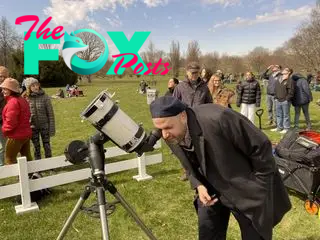Science
Why I watched the solar eclipse with my kids, a goose and 2,000 trees
Hamilton, Ontario — After a nail-biting week of "mostly cloudy" forecasts, the bright sun finally emerged over Hamilton's Royal Botanical Gardens (RBG) just in time for the moon to take a bite out of its side.
The first partial phase of the April 8 total solar eclipse had just begun. A crowd of roughly 100 eclipse chasers, including many young families, had gathered for a viewing event in the garden's arboretum — a rambling, hilly sanctuary of more than 2,200 trees perched above the western tip of Lake Ontario. Solar eclipse glasses in hand, all were hoping for the rare chance to see totality, the fleeting moment when the sun's disk is entirely blocked by the moon and daylight is engulfed by sudden darkness.
If the break in the clouds lasted another hour or so, the garden's human and animal attendants would be treated to nearly 90 seconds of eerie twilight at 3:18 p.m. Birds might cease their singing, a false sunset would wrap around the entire horizon, and bright planets would beam down from the afternoon sky.
"Every totality is different," David Galbraith, the RBG's Director of Science, explained to a crowd gathered near his solar-filtered telescope. "And Earth is the only planet where it's possible."

With the Earth, moon and sun perfectly aligned, the only trace of our home star would be a thin ring of white light circling the black moon, with jagged tendrils of light spreading into the overbearing darkness. This radiant ring is the sun's corona, its fiery outer atmosphere — although ancient cultures should not be blamed for mistaking it for the wrath of the gods made manifest.
Such a sight would not be visible from this part of North America for another 120 years. The stakes, one could say, were total.
A spot with a view (and a goose)
My family and I chose to view the eclipse from the RBG arboretum not only for the hint of 3 p.m. sunlight predicted in that morning's weather forecast but also for its natural setting — far from the streetlights of Hamilton that would automatically kick on during the darkness of totality. Likewise, we had little interest in braving the heavy traffic to nearby Niagara Falls, where a state of emergency had been declared and more than 1 million eclipse chasers were predicted to descend.
-

 Science2d ago
Science2d agoInside Capitol Hill’s Latest UFO Hearings
-

 Science2d ago
Science2d agoYou Won’t Want to Miss the Leonid Meteor Shower. Here’s How and When You Can See It
-

 Science3d ago
Science3d agoHere’s What Trump’s Win Means for NASA
-

 Science6d ago
Science6d agoWhy Risky Wildfire Zones Have Been Increasing Around the World
-

 Science6d ago
Science6d agoIt’s Time to Redefine What a Megafire Is in the Climate Change Era
-

 Science1w ago
Science1w ago4 Astronauts Return to Earth After Being Delayed by Boeing’s Capsule Trouble and Hurricane Milton
-

 Science1w ago
Science1w agoThe Elegance and Awkwardness of NASA’s New Moon Suit, Designed by Axiom and Prada
-

 Science1w ago
Science1w agoSpaceX Launches Its Mega Starship Rocket. This Time, Mechanical Arms Catch It at Landing


























